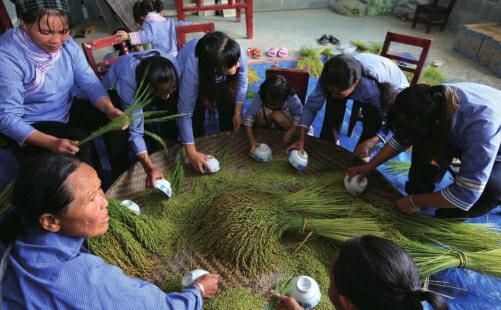Artistic Sparks
2017-10-22
An actor performs the traditional Chinese dramatic art of “face-changing” at the opening ceremony of the 10th China Acrobatics Golden Chrysanthemum Awards in Penglai, east Chinas Shandong Province, on September 16. Over 500 contestants came to compete in the event.
Winter Heating
China has regulated the use of cleaner fuel for heating in its northern region, where coal burning in winter is a major source of pollution.
In the Beijing-Tianjin-Hebei region and nearby areas, 28 cities will now use only natural gas, electricity and renewable energy for heating.
Other regions in the north should phase out the use of inferior coal, which is widely used in rural areas due to its low cost.
Smog is still a very severe problem in winter in north China. Coal accounts for more than 60 percent of Chinas primary energy consumption, much higher than the world average, and in the north, the ratio is around 80 percent.
The share of non-fossil energy is to rise to 15 percent by 2020 and 20 percent by 2030. Coal consumption will be limited to less than 58 percent of energy resources use by 2020.
Panda Tourism
Tourism in southwest Chinas Sichuan Province, home to most of the countrys wild pandas, has developed rapidly in recent years thanks to its rich cultural and natural resources and promotion.
The Fourth Sichuan International Travel Expo, which opened on September 17 in Emeishan City, will witness the signing of 28 contracts valued at 68.5 billion yuan ($10.5 billion), said Fu Yonglin, Director of the Sichuan Tourism Development Committee.
Featuring opening up and green development driven by tourism, the weeklong expo has attracted more than 2,000 guests from 74 countries and regions, including the United States, Australia, Russia and Germany.
In 2016, Sichuan hosted 630 million domestic tourist arrivals and 3 million overseas visitors. Tourism accounted for 8.4 percent of the provinces economy.
In the fi rst half of this year, Sichuans tourism revenue grew 19.3 percent year on year to reach 45.8 billion yuan ($7 billion).
“We strive to develop tourism into an industry of more than 100 billion yuan ($15.27 billion),”said Peng Lin, Secretary of the Communist Party of China Leshan Committee, home to Emeishan Mountain and the Leshan Giant Buddha, both inscribed on the UNESCO World Heritage List.
During the expo, seminars will be held to discuss sustainable tourism development.endprint
Health Modernization
China ranks 59th among 131 countries in terms of health modernization, according to a report released on September 16.
He Chuanqi, head of the China Center for Modernization Research of the Chinese Academy of Sciences, suggested a roadmap for Chinas health development in fi ve areas: systems, daily life, service, environment and treatment.
The report, based on data from 2014 and earlier, categorized 25 countries as “developed” in health(e.g. Sweden); 22 countries, “moderately developed” (e.g. Russia); 33 countries, “primarily developed”(e.g. China); and 51 countries, “underdeveloped” (e.g. Kenya).
In 2016, the State Council, Chinas cabinet, issued guidelines on building a healthy China.
Green Industrial Park
The UN Industrial Development Organization (UNIDO) on September 18 certifi ed Chinas fi fth “green industrial park.”
The status was conferred on the Quanzhou Economic and Technological Development Park in southeast Chinas Fujian Province, a local light industry hub bristling with manufacturers of clothes, shoes, digital devices, machinery and medicines.
UNIDOs green industrial park categorization refers to a new type of industrial park which maximizes the effi ciency of resources and energy utilization and minimizes pollutants generated from industrial production.
“The certifi cation will help improve the environment in the region and set an example for making the transition from an intensive, industry-led economy to a greener growth model,” said Lin Jinming, a senior Quanzhou offi cial.
Since 2012, UNIDO has certif eid four such parks in China, located in Urumqi, Zhangye, Lianyungang and Yantai cities.
Chieftain Tombs
Archaeologists have discovered fi ve more tombs belonging to Tusi chieftains in southwest Chinas Guizhou Province.
The Tusi chieftain system was adopted by feudal Chinese emperors to govern ethnic minorities in the southwest between the 13th and early 20th centuries. Tusi refers to a tribal leader appointed as an imperial offi cial by the imperial court.
The newly found tombs are located in Zunyi. Three belong to Tusi chieftains from a family surnamed Yang who ruled during the Yuan Dynasty (1271-1368). Nine Yang family tombs have previously been discovered, according to the Guizhou Provincial Institute of Cultural Relics and Archaeology.
Zunyi was historically called Bozhou. The Yang family, one of the four major chieftain families in Guizhou, governed Bozhou for 725 years until 1601, when the last chieftain, Yang Yinglong, died during a failed rebellion.endprint
The tombs will provide rich material for research into the Tusi chieftain system and culture, according to the institute.
First Maglev Line
Beijings fi rst medium-low speed maglev line is scheduled to start operation at the end of the year, the operator said on September 16.
Beijing Subway said it was preparing test runs on the new line.
Initially, trains will stop at seven of the lines eight stations, as one station—Pingguoyuan—is still under construction and is expected to open in late 2019, the company said.
In the fi rst stage of its operation, the line will feature 10 trains, running at up to 80 km per hour and with a designed maximum carrying capacity of 1,032 passengers each.
The 10.2-km line will help improve transport in Mentougou District and optimize the industrial structure in Shijingshan District, according to the operator.
Maglev trains are safer and cheaper than current metro and light rail trains. Electromagnets and specially designed tracks prevent the trains from derailing or overturning. They can even operate in severe weather conditions and produce much less noise and zero local emissions.
Mutual Learning
A student from the Confucius Institute of the University of Zambia learns Chinese painting at No.42 Middle School in Shijiazhuang, capital of north Chinas Hebei Province, on September 14. Twenty-fi ve students and teachers from the University of Zambia attended the cultural exchange activity.
Expanding Lake
The surface area of Chinas largest inland saltwater lake has expanded further this year due to increased rainfall, the Qinghai Institute of Meteorological Sciences said on September 18.
The surface area of Qinghai Lake, situated in northwest Chinas Qinghai Province, reached 4,476 square km in September, an increase of 51 square km from the same period a year earlier, data from the institute showed.
The largest surface area on record was 4,477.53 square km, which was documented in 1974.
Qinghai Lake plays an important role in the ecological security of the Qinghai-Tibet Plateau. The lakes water level dropped to the lowest recorded level in 2004, but since 2005, it has been expanding thanks to abundant precipitation in surrounding areas and increased snow melt due to climate change.
As precipitation levels are expected to stay high in September and October, experts believe the surface of the lake will continue growing in 2017.endprint
“The expansion of the lake is benefi cial for local ecological protection and the prevention of desertifi cation in surrounding areas,”said Liu Baokang, a senior engineer at the institute.
Celebrating a Big Harvest
Farmers of the Zhuang ethnic group thresh rice in Fengshan County, south Chinas Guangxi Zhuang Autonomous Region, on September 17. Members of the Zhuang ethnic group in Guangxi traditionally collect some rice just before the main harvest season to make sweet and soft “Changqing” rice which is eaten on harvest days for good luck.
Investment Boost
The government has released a slew of measures including improving government services and offering more fi nancing channels to encourage private investment.
The measures also include delegating power, strengthening regulation, and attracting more private funds for public-private partnerships, according to a guideline issued by the State Council on September 15.
The guideline came following a drop in private investment growth. Private fi xed assets investment (FAI), which accounts for more than 60 percent of the total FAI, grew 6.4 percent year on year in the fi rst eight months of the year, slowing from a 6.9 percent rise for January-July.
Poor implementation of government policy, high costs and limited access to funding are the main obstacles to private investment, the guideline said.
The government will improve the credit rating system and optimize the management of credit extensions for private businesses, increasing channels for them to raise funds.
The country will also lower operating costs for private companies, and encourage them to participate in major programs such as the Made in China 2025 initiative, modern agriculture and technological upgrades in industrial enterprises.
Since the 1980s, private businesses have played a bigger role in Chinas economic development. They contribute more than 60 percent of the national GDP growth and provide over 80 percent of jobs in urban areas.
Home Prices
Chinas property market continued to show signs of cooling as home prices fell or posted slower growth in major cities amid tough control policies, offi cial data showed on September 18.
On a yearly basis, of the 70 cities surveyed in August, the pace of new home price growth slowed in 15 major cities compared with the same month in 2016, the National Bureau of Statistics (NBS) said.endprint
On a month-on-month basis, new home prices fell or remained fl at in 13 cities in August, down from 14 in July, but up from 10 in June.
The growth pace in property development investment also mildly retreated in the fi rst eight months of the year, according to the NBS.
In the January-August period, the fi xed assets investment hit 39.42 trillion yuan ($6 trillion), up 7.8 perc ent year on year. But the pace was slower than the 8.3-percent increase in the fi rst seven months.
Commercial housing sales measured by fl oor area gained 12.7 percent in the January-August period, retreating 1.3 percentage points from the January-July period.
By the end of August, 623.5 million square meters of property remained unsold, down by 11.4 million square meters from a month earlier.
Hustle and Bustle
Visitors pack an exhibition hall of the 14th China-ASEAN Expo in Nanning, capital of south Chinas Guangxi Zhuang Autonomous Region, on the opening day, September 15.
The four-day event highlighted trade and investment in China, ASEAN and some other countries along the China-proposed Silk Road Economic Belt and 21st-Century Maritime Silk Road.
New Jobs
Around 5.5 percent of Chinas labor force work in the rapidly expanding sharing economy, according to a report from the top economic planner on September 18.
The market value of the Internet-based sharing economy exceeded 2 trillion yuan ($305.8 billion) in 2016, with more than 50 million people working in the sector, said a report released by the National Development and Reform Commission.
The success of business models such as bike-sharing platforms, including Mobike and Ofo, has inspired an increasing number of sharing enterprises eager to ride the wave.
Meanwhile, on the back of strong government support for innovation and entrepreneurship, industries such as car sharing, education, entertainment and healthcare have prospered, seeing double-digit growth in demand for personnel last year, the report said.
“Mass innovation and entrepreneurship have played an important role in increasing employment,” the report said, citing rapid expansion in emerging industries such as cloud computing, industrial robots and new-energy vehicles.
The latest Global Innovation Index showed China rose three places to 22nd on the list of the worlds most innovative nations in 2017, the only middle-income country to join the top 25 innovative economies.endprint
